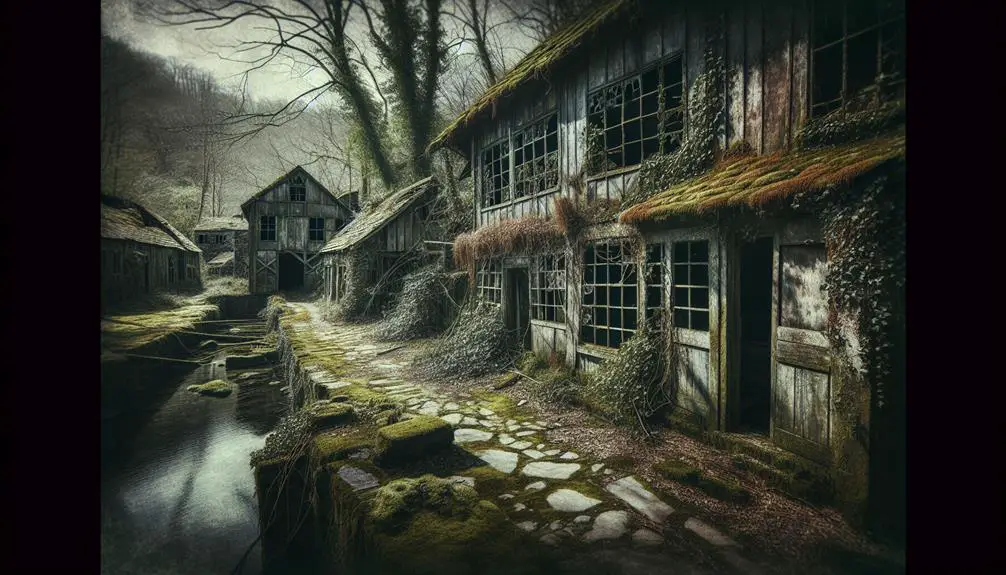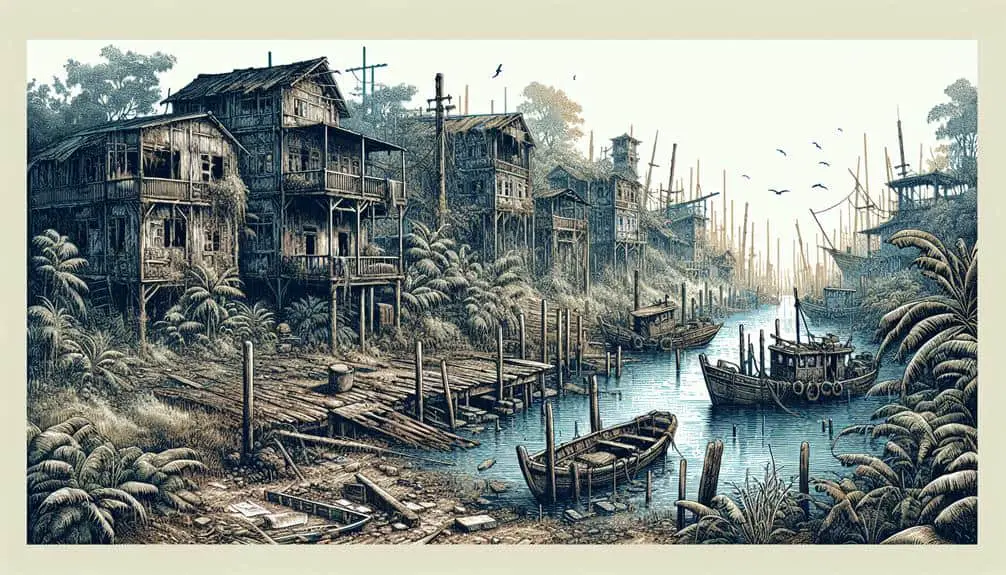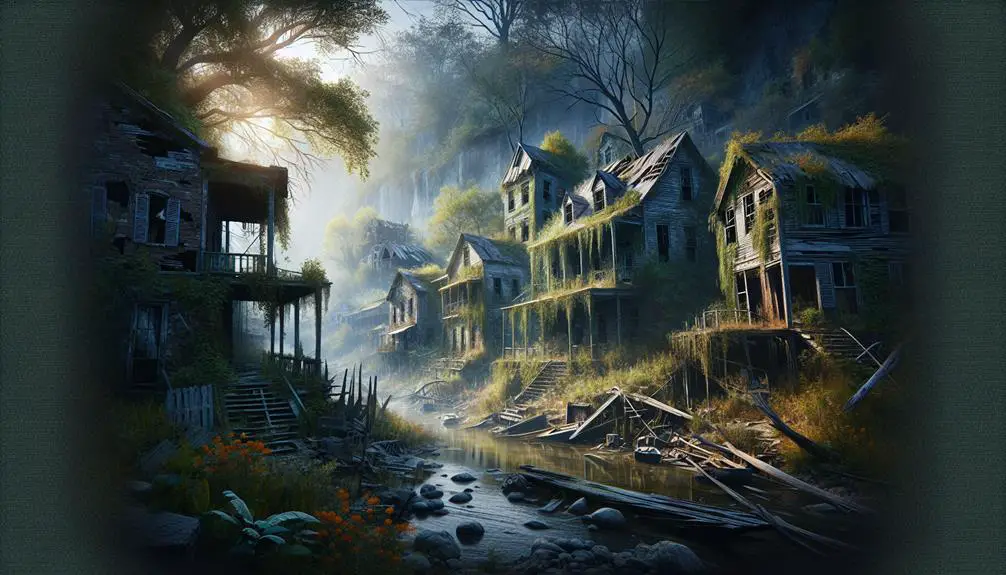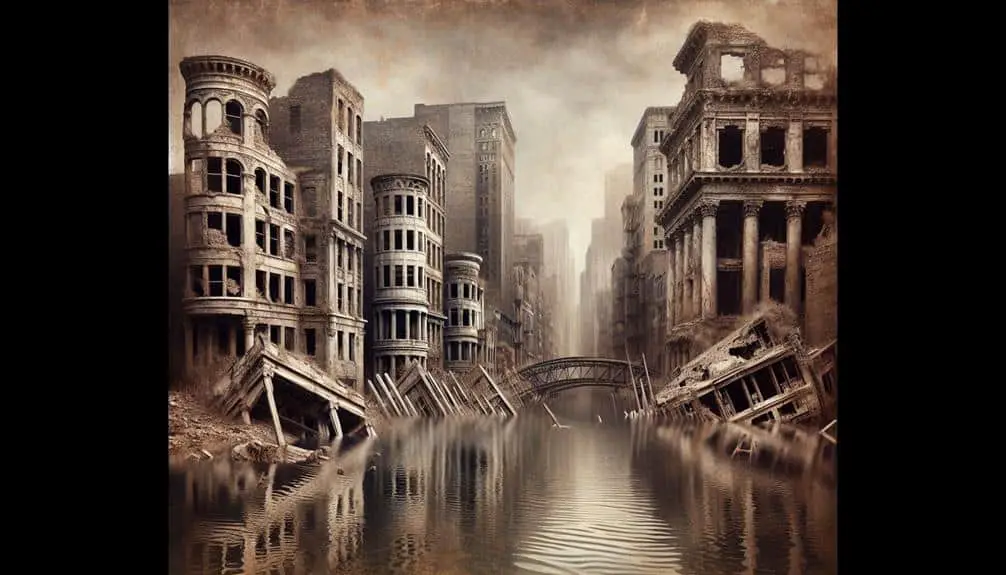Explore the mystery of US riverbank ghost towns, where history meets nature in their forgotten submergence. These towns, linked to the gold rush era, bustled with life before time swallowed them whole. Devastating floods, erosion, and human alterations conspired to erase these thriving communities. The delicate balance between preservation and flood risks remains a key challenge. Yet, beneath the waters lie untold stories and hidden relics waiting to be unearthed. Discover the secrets of these submerged towns, where every sunken relic whispers of a past waiting to be understood.
Key Points
- Geological shifts and erosion contribute to submergence.
- Urban development alters natural river flows, leading to submergence.
- Construction projects like dams exacerbate erosion effects.
- Floods erode structures and wash away remnants of ghost towns.
- Balancing preservation efforts with flood risks is crucial.
Historical Significance of Riverbank Ghost Towns
Exploring the historical significance of riverbank ghost towns reveals a rich tapestry of human settlement, economic booms, and eventual decline. These towns hold a deep cultural heritage, showcasing the lives and stories of past inhabitants. The preservation of these towns is essential in understanding our history and the factors that led to their abandonment.
Many riverbank ghost towns emerged during the gold rush era, with settlers flocking to these areas in search of prosperity. These towns were hubs of activity, filled with saloons, general stores, and bustling communities. However, as the gold reserves dwindled or economic shifts occurred, these towns faced decline, leaving behind remnants of a bygone era.
Historical preservation efforts aim to capture the essence of these ghost towns before they're lost to time. By documenting the architecture, artifacts, and stories of these towns, we can gain insight into the challenges faced by early settlers and the impact of changing economic landscapes. Preserving these towns is essential for ensuring that future generations can appreciate and learn from our shared history.
Impact of Flooding on Ghost Towns
The presence of rivers near ghost towns has posed significant challenges, particularly regarding the impact of flooding on these abandoned settlements. When rivers overflow, the environmental consequences can be devastating. Floodwaters can erode structures, wash away remnants of the past, and introduce pollutants into the ecosystem. This not only affects the physical remains of the ghost town but also has broader implications for the surrounding environment.
Moreover, flooding can lead to community displacement. Residents of nearby areas may have to evacuate, disrupting any attempts to preserve the cultural heritage of these ghost towns. The flooding of these sites not only washes away physical artifacts but also displaces any lingering connection to the past that descendants may have felt.
As ghost towns are often rich in historical significance, the flooding of these areas can hinder urban development plans that may have aimed to revitalize or repurpose these spaces. Balancing the need for preservation with the risks posed by flooding is a delicate task, requiring careful consideration of both the environmental impact and the cultural value of these submerged settlements.
Factors Contributing to Submergence
Amidst the intricate interplay of geological shifts and human settlement patterns lies the underlying explanation for the submergence of US riverbank ghost towns. Erosion effects play a significant role in the gradual disappearance of these once-thriving communities. Over time, the relentless force of water erodes the riverbanks, causing them to crumble and ultimately submerge the towns built upon them.
Urban development also contributes to the submergence of these ghost towns. As cities expand and populations grow, there's an increased demand for land along riverbanks. This leads to extensive construction projects, including dams and levees, which can alter the natural flow of rivers and exacerbate erosion effects. The combination of natural erosion processes and human interventions accelerates the submergence of these historic settlements.
Understanding these factors is imperative in grasping the complex dynamics that have led to the forgotten and submerged state of US riverbank ghost towns.
Preservation Efforts and Challenges
In the domain of conserving US riverbank ghost towns, addressing the dual challenges of environmental degradation and historical significance stands as a pivotal endeavor. The challenges faced in preserving these sites are multifaceted. Environmental factors like erosion, flooding, and vegetation growth can pose significant threats to the structural integrity of these towns. Balancing preservation efforts with the need to protect the natural surroundings requires careful planning and resource allocation.
Additionally, the historical significance of these ghost towns presents another layer of complexity. Ensuring that the stories and heritage of these communities are accurately preserved for future generations is a delicate task that demands attention to detail and sensitivity to cultural nuances.
To overcome these challenges, various preservation strategies can be employed. Implementing protective measures such as stabilizing structures, controlling water flow, and conducting regular maintenance can help safeguard these sites from further deterioration. Collaborating with local communities, historical societies, and government agencies can also provide valuable support in raising awareness and securing funding for preservation initiatives.
Exploring Submerged Ghost Towns
Delving into the depths of submerged ghost towns reveals a secret world where echoes of the past resonate through sunken structures and forgotten streets. Underwater exploration of these lost settlements offers a unique opportunity to uncover hidden histories and lost artifacts. The murky waters hold the remains of buildings once bustling with life, now silent and eerie in their underwater repose.
As you venture beneath the surface, you may come across remnants of old homes, abandoned storefronts, and rusted machinery, all frozen in time. These submerged ghost towns act as time capsules, preserving glimpses of a bygone era that would otherwise be lost to the depths of history.
Navigating through the submerged streets, you can almost feel the presence of the communities that once thrived in these now-desolate waters. Each discovery adds another piece to the puzzle of understanding these forgotten places, offering a tangible connection to the past that lies buried beneath the surface.
Frequently Asked Questions
Are There Any Supernatural Stories or Legends Associated With the Riverbank Ghost Towns?
Have you heard the eerie tales of supernatural sightings in US riverbank ghost towns? Urban legends intertwine with forgotten history, creating a tapestry of mystery and intrigue that captures the imagination and sparks curiosity.
How Do Local Communities Feel About the Preservation Efforts for These Submerged Ghost Towns?
Local perspectives on preservation efforts for submerged ghost towns vary. Some communities are deeply involved, seeing it as a way to honor history. Others are indifferent, focusing on present needs. Community involvement is key to successful preservation.
Are There Any Efforts to Document the History and Stories of the People Who Used to Live in These Ghost Towns?
Efforts to document the oral histories of those who once inhabited these ghost towns are vital. Preservation initiatives not only honor the cultural significance but also foster community engagement, ensuring these stories are not lost.
Have Any Artifacts or Structures From the Submerged Ghost Towns Been Salvaged or Preserved?
Artifacts from submerged ghost towns hold historical significance. Efforts have salvaged items, preserving glimpses of the past. By documenting and displaying these remnants, the stories of those forgotten towns are kept alive.
Are There Any Ongoing Research Projects or Studies Focused on the Environmental Impact of These Submerged Ghost Towns?
Just like a detective unravels a mystery, ongoing research projects investigate the environmental impact of submerged ghost towns. These studies not only shed light on their cultural significance but also inform preservation efforts.



